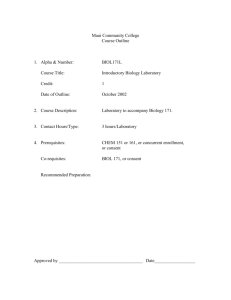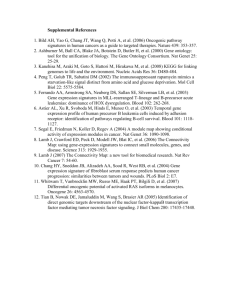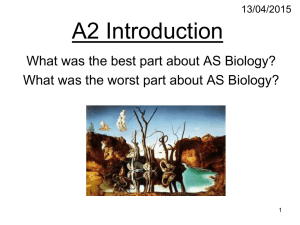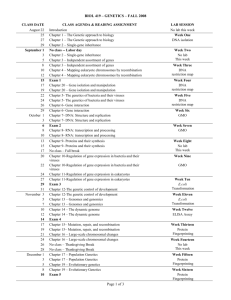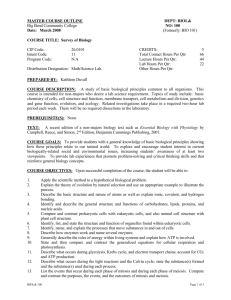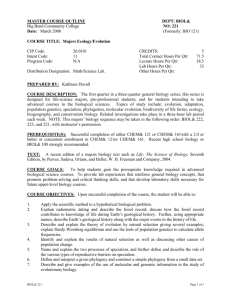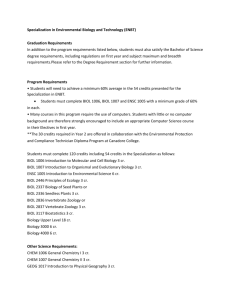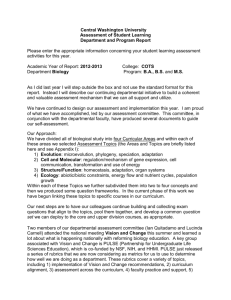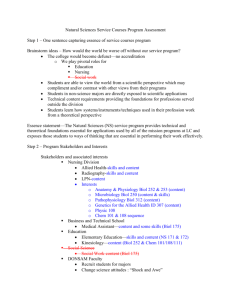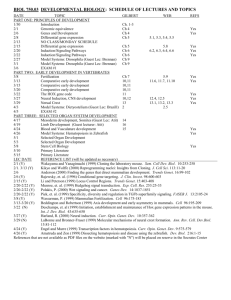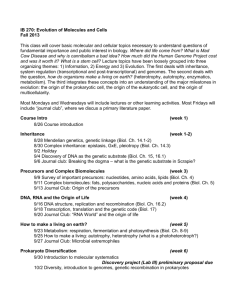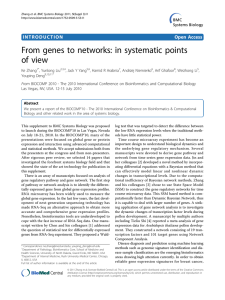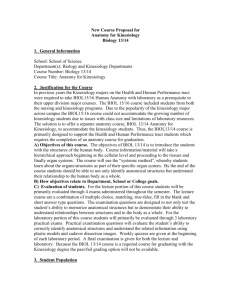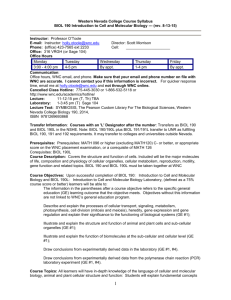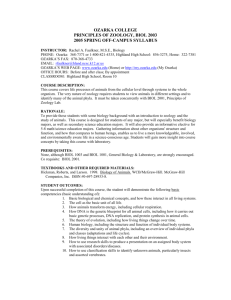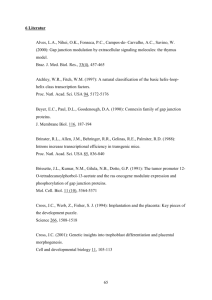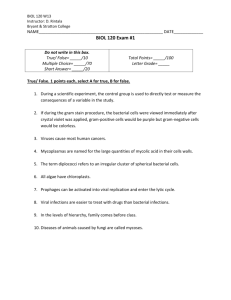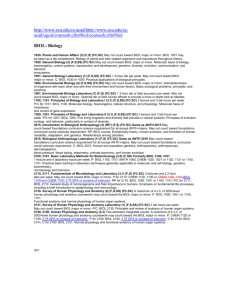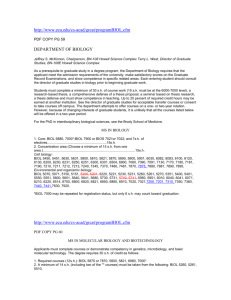BIOL 222 - Big Bend Community College
advertisement
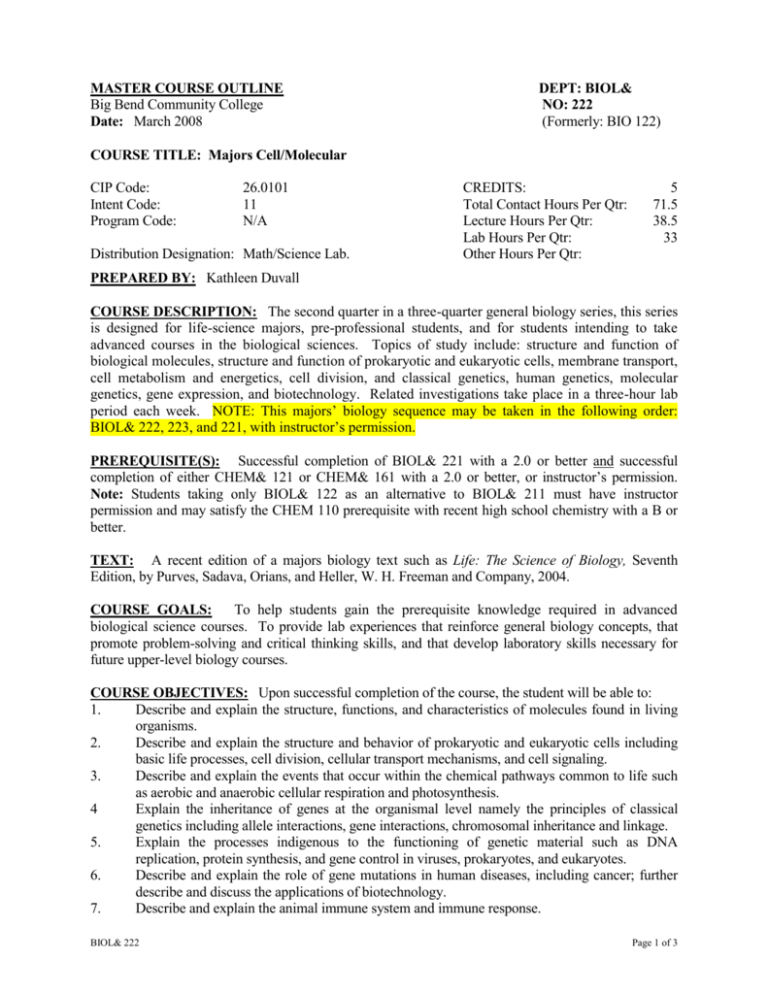
MASTER COURSE OUTLINE Big Bend Community College Date: March 2008 DEPT: BIOL& NO: 222 (Formerly: BIO 122) COURSE TITLE: Majors Cell/Molecular CIP Code: Intent Code: Program Code: 26.0101 11 N/A Distribution Designation: Math/Science Lab. CREDITS: Total Contact Hours Per Qtr: Lecture Hours Per Qtr: Lab Hours Per Qtr: Other Hours Per Qtr: 5 71.5 38.5 33 PREPARED BY: Kathleen Duvall COURSE DESCRIPTION: The second quarter in a three-quarter general biology series, this series is designed for life-science majors, pre-professional students, and for students intending to take advanced courses in the biological sciences. Topics of study include: structure and function of biological molecules, structure and function of prokaryotic and eukaryotic cells, membrane transport, cell metabolism and energetics, cell division, and classical genetics, human genetics, molecular genetics, gene expression, and biotechnology. Related investigations take place in a three-hour lab period each week. NOTE: This majors’ biology sequence may be taken in the following order: BIOL& 222, 223, and 221, with instructor’s permission. PREREQUISITE(S): Successful completion of BIOL& 221 with a 2.0 or better and successful completion of either CHEM& 121 or CHEM& 161 with a 2.0 or better, or instructor’s permission. Note: Students taking only BIOL& 122 as an alternative to BIOL& 211 must have instructor permission and may satisfy the CHEM 110 prerequisite with recent high school chemistry with a B or better. TEXT: A recent edition of a majors biology text such as Life: The Science of Biology, Seventh Edition, by Purves, Sadava, Orians, and Heller, W. H. Freeman and Company, 2004. COURSE GOALS: To help students gain the prerequisite knowledge required in advanced biological science courses. To provide lab experiences that reinforce general biology concepts, that promote problem-solving and critical thinking skills, and that develop laboratory skills necessary for future upper-level biology courses. COURSE OBJECTIVES: Upon successful completion of the course, the student will be able to: 1. Describe and explain the structure, functions, and characteristics of molecules found in living organisms. 2. Describe and explain the structure and behavior of prokaryotic and eukaryotic cells including basic life processes, cell division, cellular transport mechanisms, and cell signaling. 3. Describe and explain the events that occur within the chemical pathways common to life such as aerobic and anaerobic cellular respiration and photosynthesis. 4 Explain the inheritance of genes at the organismal level namely the principles of classical genetics including allele interactions, gene interactions, chromosomal inheritance and linkage. 5. Explain the processes indigenous to the functioning of genetic material such as DNA replication, protein synthesis, and gene control in viruses, prokaryotes, and eukaryotes. 6. Describe and explain the role of gene mutations in human diseases, including cancer; further describe and discuss the applications of biotechnology. 7. Describe and explain the animal immune system and immune response. BIOL& 222 Page 1 of 3 COURSE CONTENT OUTLINE: Cell Structure and Function Chemical Bonding, Water, and pH Formation, Structure, and Function of Macromolecules Features of Prokaryotic and Eukaryotic Cells Cellular Membranes and Membrane Transport Enzymes, Energy, and Metabolism Cellular Pathways That Harvest Chemical Energy Photosynthesis, Photorespiration, and CAM and C4 Modifications Information and Heredity Chromosomes, the Cell Cycle, and Cell Division Mendelian Genetics, Allele and Gene Interactions, Chromosomes and Sex Linked Inheritance DNA Structure, Replication, and Repair From DNA to Protein: Transcription, Translation, and Mutations Reproduction, Recombination, and Regulation of Gene Expression in Viruses and Prokaryotes The Eukaryotic Genome and Its Expression Cell Signaling and Communication –Signals, Receptors, and Signal Transduction Recombinant DNA and Biotechnology Genetic Origins of Human Diseases, Genetic Screening and Treatment, Cancer Natural Defenses against Disease – Immune System and Immune Response EVALUATION METHODS/GRADING PROCEDURES: Lecture Exams and Final Exam Homework, Project, and Quizzes Lab Reports, Lab Mid-Term, and Lab Final 60% 15% 25% The grade scale may be adjusted as the instructor deems necessary but usually approximates: 100 - 96% 4.0 76 - 70% 2.4 - 2.0 95 - 90% 3.9 - 3.5 69 - 64% 1.9 - 1.5 89 - 84% 3.4 - 3.0 63 - 57% 1.4 - 0.7 83 - 77% 2.9 - 2.5 56 - 0% 0.0 Lab is an essential part of this class and is required for credit. Students missing more than two labs or missing the mandatory lab final will not be given credit for this course. The lab final exam is a practical exam in which students rotate through stations that each contain two questions and usually present a hands-on exhibit. Diagrams, models, 35mm slides, and microscope slides are all commonly used. Lab exam question types include identification, analysis, and prediction of results. PLANNED TEACHING METHODS/LEARNING STRATEGIES: X Lecture X Laboratory Supervised Clinical BIOL& 222 X Small Group Discussion X Audiovisual Individualized Instruction X Special Project Other (List) Page 2 of 3 Division Chair Approval BIOL& 222 Page 3 of 3


